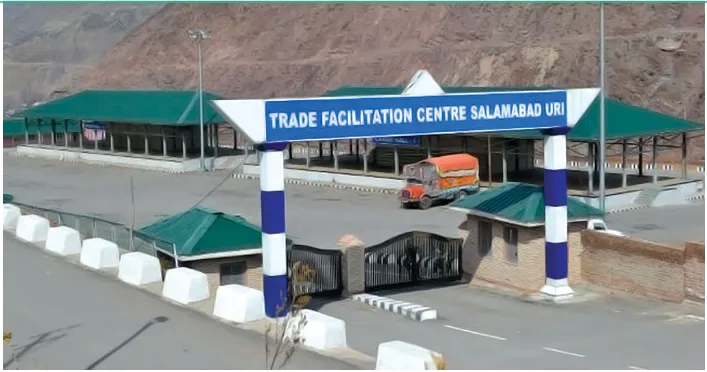76 miles from Srinagar, 42 from Muzaffarabad, and 49 from Poonch, Uri is a beautiful town situated on both sides of River Jehlum. It is a sub-division extending from Peeriniya to Gawalta and from Zainpora to Dulanja. Once Uri was a central place for Poonch, Muzaffarabad and Baramulla towns.
From 1947 till date Uri witnessed may ups and downs; wars, shelling and firing, surgical strike, and earthquake. During 1947 war Uri was divided into two parts, about half of Uri tehsil went under the control of Pakistan. Families were divided, and that separation continues. Thousands of such divided families cannot gather on the occasions of joy or grief.
The ceasefire agreement in 2003 between Indo-Pak governments, and opening up of Srinagar–Muzaffarabad road in 2005 were a big relief to the people of Uri. The residents of LoC village had a few years of peace, but after 10 years, trouble revisited and today we are, on a daily basis, facing shelling and firing in Hajipeer sector, Kamalkote Gawalta and Boniyar sector. Near about sixty villages of Uri division become a target. The villages like Nambla, Mothal, Soura, Hathlanga, Silkote, Balkote, Tulawari, Batgran, Churanda, Gowalan, Dardkote, Isham, Gowalta, Urosa, Dalanja, and Kamalkote face difficulties; they cannot even go for farming, and the schools remain impacted in these villages. For most of their time the villagers remain inside homes or in bunkers; till now dozens of locals have died in shelling, or by firing. In the border area there are a number of persons disabled by mines.
Pre-1947 Uri is said to be a tehsil of Muzaffarabad district. This tehsil was separated from Karnah, Muzaffarabad & Poonch by Qazi Nag, Neelkanth Duburdun hills and Hajipeer pass. Presently, Uri is a sub division of Baramulla district, comprising two tehsils, Uri and boniyar, and four rural development blocks – Uri, Boniyar, Paranpilla & Bijhama. As per the elders of the town, before 1947, Uri was a central place for Baramulla, Poonch, Muzaffarabad as Jhelum cart road was the main link from J&K to outside. The Punjabi & Kashmiri businessmen traveled to other parts of Hindustan through this link, Mughals, Sikh gurus and Sufi saints travelled on this road; the traces of this travel history remain in the area. During Afghan rule in Kashmir, 1753-1819, Uri was the main route connecting Srinagar with Kabul.

As per reports, in 1946 when Sheikh M Abdullah was arrested in Kashmir, during Quit Kashmir Movement, Pandit Jawaharlal Nehru had come to Kashmir to get him released, but he was also arrested by the state police at Domel, Muzaffarabad, and kept in Uri Dak Bunglow.
As per the elders, political awakening in Uri started in 1970s when a few locals played an important role in the restoration of democracy. In 1972, first time, elections were held in Uri and M Shafi was elected as MLA. From then onwards schools and hospitals were opened in Uri and locals were provided government jobs. As a result of that awakening, today Uri is politically active than any other rural part of Kashmir. Not just that, it is better developed than other border towns of J&K like Karnah, Teetwal, Gurez, Machil. Prass Mandi, Loran, and Nowshera.
The NHPC constructed two power projects in Uri, NHPC1 & 2. Both projects played a vital role in the development of Uri sub division, but surprisingly locals cannot use electricity from these projects. Lower Jehlum project is constructed by PDD, Power Development Department. All these projects cumulatively had a good impact on the economic condition of this area. In fact it was in 1906 that Mohura power projecte was established, but from 1993 it’s defunct, and no one cares about that.
The walnut market at Lagama, (old capital of Uri) is a significant spot in the town. The traders from all over the valley come to Lagama for the walnut business, even traders from Delhi come to this place to purchase walnut.
In 2005 opening up of the Srinagar-Muzaffarabad road brought Uri again into limelight. A trade centre was established at Salamabad, Uri. But last year the road was closed and it adversely impacted the people in this area, especially the divided families. It also effected the livelihood of the locals.
The Uri sub-divison is dominated by the Pahari speaking people, about 65% are Pahari speaking population followed by Gujars and Kashmiris. The Pahari speaking people demand tribe status from a long time now. The then prime minister of India, HD Devigoda addressed a public rally at Uri stadium in presence of the then chief minister, Dr Farooq Abdullah, and then finance minister of J&K, & MLA Uri, M Shafi Uri. He assured to give ST status to Paharis, but till date, nothing moved.
In Uri, people of different faiths live together. Hindu families are residing in Lagama, Bandi, Rajarwani & in Uri town. There are some Sikh families in Salamabad, Uri & in Lagama town. The relations between Muslims, Sikhs, and Hindus have always remained very cordial, even in the times of violence.
Maqsood Ahmad is Producer and Editor of the popular program SHAHERBEEN, on All India Radio, Srinagar)






